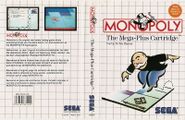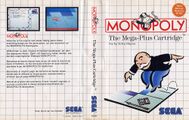Difference between revisions of "Monopoly"
From Sega Retro
| Line 55: | Line 55: | ||
| region=US | | region=US | ||
| cover=Monopoly SMS US cover.jpg | | cover=Monopoly SMS US cover.jpg | ||
| + | | cart=Monopoly SMS US Cart.jpg | ||
| manual=Monopoly sms us manual.pdf | | manual=Monopoly sms us manual.pdf | ||
}} | }} | ||
Revision as of 09:20, 24 December 2013
| Monopoly | |||||
|---|---|---|---|---|---|
| System(s): Sega Master System | |||||
| Publisher: Sega | |||||
| Developer: Nexa | |||||
| Genre: Table | |||||
| Number of players: 1-10 | |||||
|
This short article is in need of work. You can help Sega Retro by adding to it.
- For the Mega Drive game, see Monopoly (Mega Drive).
Monopoly is a licensed game based upon the Monopoly board game, and was developed by Nexa and published by Sega for the Sega Master System. Up to 10 players can play in a single game, any of whom can be computer-controlled. The cartridge features a battery back-up RAM, so games can be saved and resumed later.
Another Monopoly game was released for the Mega Drive in 1992, published by Parker Brothers who also manufacture the board game.
History
Development
Monopoly was the first Master System game to be developed in the US in an attempt to capture the mood of the American public, who at this point were greatly favouring Nintendo's rival console, the NES, over Sega and their Master System. All previous games, despite sometimes being localised, were developed by Sega and other companies within Japan, although ironically the project originally started with Chinese developers at the helm.
Development on Monopoly took about six months - three months in Nexa were brought on-board to "save" the project after initial testing was not considered to be up to Sega's standards.
Credits
- Project Leader: R. Anton Widjaja
- Programmers: Bill Chau, Jinda Pan, Kevin T. Seghetti, Scott L. Statton
- Artists: Dan Guerra, Tim Dunn
Physical Scans
| Sega Retro Average | |||||||||||||||||||||||||||||||||||||||||||||||||||||||||||||||||||||
|---|---|---|---|---|---|---|---|---|---|---|---|---|---|---|---|---|---|---|---|---|---|---|---|---|---|---|---|---|---|---|---|---|---|---|---|---|---|---|---|---|---|---|---|---|---|---|---|---|---|---|---|---|---|---|---|---|---|---|---|---|---|---|---|---|---|---|---|---|---|
|
| 72 | |
|---|---|
| Based on 13 reviews | |
- ↑ ACE, "January 1989" (UK; 1989-xx-xx), page 77
- ↑ Complete Guide to Consoles, "" (UK; 1989-10-16), page 62
- ↑ Complete Guide to Consoles, "Volume IV" (UK; 1990-11-xx), page 101
- ↑ The Complete Guide to Sega, "" (UK; 1991-05-xx), page 58
- ↑ Computer Action, "Juli/August 89" (DK; 1989-0x-xx), page 36
- ↑ Console XS, "June/July 1992" (UK; 1992-04-23), page 142
- ↑ The Games Machine, "December 1988" (UK; 1988-11-17), page 51
- ↑ Mean Machines Sega, "October 1992" (UK; 1992-09-xx), page 135
- ↑ S: The Sega Magazine, "July 1990" (UK; 1990-06-07), page 24
- ↑ Sega Power, "October 1991" (UK; 1991-09-05), page 58
- ↑ Sega Pro, "February 1992" (UK; 1992-01-16), page 19
- ↑ Sega Pro, "April 1993" (UK; 1993-03-11), page 71
- ↑ Tilt, "Mars 1989" (FR; 1989-0x-xx), page 76



